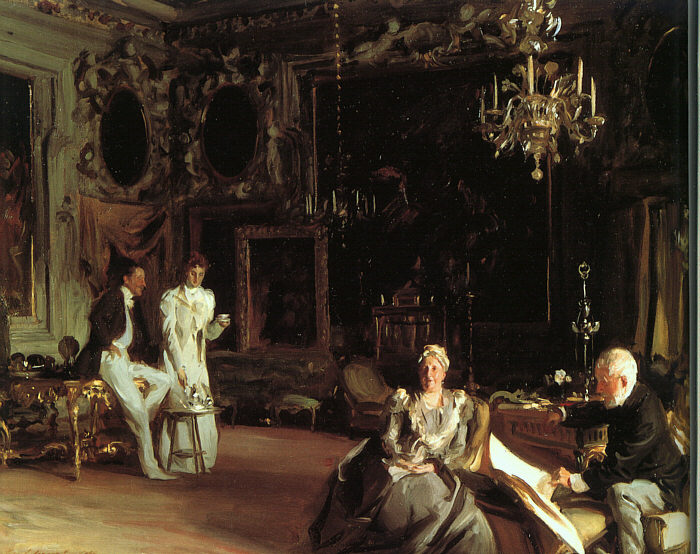| Q:
What are some of your shorter term goals?
Right now I'm having fun weaving
the various people surrounding Sargent's life into an understandable tapestry.
Again, I'm trying to picture Sargent in the context of these people.
So I'm trying to fill out the narrative chronology a bit more.
Q: Like who for example?
There is a number of people very
close to Sargent and at various stages of his life. You see the names Vernon
Lee, Ralph Curtis, Henry James, Isabella Stewart Gardner, Robert
Louis Stevenson showing up time and again.
From a historian's view, it's interesting
to see how these people fit together. I mean, you're more apt to think
of Monet, Degas, Renoir, all hanging together, and can sort of see
Sargent fitting in there too at the edges, but then -- at least for me
I tend to compartmentalize -- so it's cool to try and picture guys like
Stevenson and James -- literary giants -- hanging out with Sargent too.
And as I read through all this stuff there are all these names that I don't
know -- who aren't like huge, but were significant at the time and it's
fun to learn about them.
But what I'm really having fun with
right now is this expatriate American community that sort of hangs around
itself as they travel all over Europe -- not together -- but wherever they
are they sort of gravitate to each other. Not that they were elitist but
more like they're family.
Take a name like Ralph Curtis --
who is this chap? Well, I know he was with Sargent the day of the salon
disaster in 1884 -- Madame X, and I know he wrote a letter
to his family about it. I also know he went on trips together to study
art together and I know he was a painter.
Then someone sends me an image John
painted of Ralph's wife in 1898,
and then I learn from one of the books that he's dad and Ralph's dad were
cousins. And so it's kind of like peeling an onion. and it starts to become
more interesting.
And then I learn that Ralph's parents
own a large
place in Venice and Sargent had stayed with them in 1882 -- two years
before the Madame X scandal -- and he stayed there many times afterwards.
Not only that, but he painted Ralph's
mom's portrait when he visited during the years when he does his Venetian
Studies. So now I know why Ralph writes his parents and why they are
so interested in Sargent.
And then you come across a painting
like An
Interior in Venice done in 1899. This is really peculiar because
it's so unlike any of his other work. The brush strokes are modern but
it looks almost 18th century. So if I hadn't dug deeper this painting would
just sit there as being sort of out of place.
Q: So what did you learn?
The painting is of the interior of
Palazzo, Barbaro, on the Grand Canal in Venice. It's where Sargent stayed
with the Curties (Ralph Curtis and his parents) when he was in Italy. The
younger man on the left in the background is Ralph Curtis, the younger
woman with him is his wife that John painted in. The older couple is Ralph's
parents.
Nice digs, huh?
I got so excited when I learned this
because it ties together almost two decades, and the painting is no longer
just curious, but once again telling of Sargent's life.
So like anyone, they start to become
three dimensional and you can start to understand the person through the
different perspectives of who they hang out with.
This last week or so I looked up
Edward Darley Boit -- you know -- of the Daughters
of Edward Darley Boit painting. He was a painter, and he and Sargent
shared a friendship for a long time. I knew nothing about this guy -- who
was also an expatriate, and it was neat to look up his painting on the
net-- I found a couple and I really liked them. [The
links to those paintings have since gone bad]
So that's sort of the stuff I'm doing
now.
Q: Is this showing up in your
pages?
Sort of.
I'm doing it on my own and I'm trying
to layer the narrative of my chronology text into more of a story -- but
i'm not sure it's working -- it could be just confusing to people at first
read. There are an awful lot of names to keep straight.
On my wish list is to have a Who's
Who of Sargent's life, but that's going to require writing a short Bio
on each of these people. |
